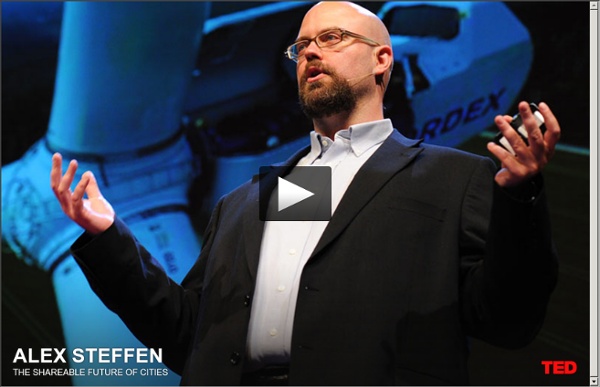



An Efficient 60 Watt LED Bulb For Under $15 | Ecopreneurist CleanTech Published on August 30th, 2011 | by Elizabeth Smyth Yesterday, Lighting Science Group and Dixon Technologies announced one of their first joint products: A high-performance, omnidirectional 60-watt equivalent A19 LED bulb that retails for under $15. According to the company, “The newly announced bulb fits perfectly into existing screw-in light sockets and creates a clean, bright light level equivalent to a conventional 60-watt incandescent bulb using 85% less electricity.” Currently, the majority of 60W LEDs retail in the $40 range. The companies confirm this new technology will go on to power a full line of products, including street lights, outdoor and industrial light fixtures and replacement bulbs. The new LED bulb will be available in India by the end of the year and sold worldwide by early next year. Image source: Lighting Science Group / PR Newswire.LSG press release. About the Author
Phase III - 010: Kleine Arbeit, noch kleinere Geschichten und große Aufmerksamkeit HTML5-Player läuft nicht? Wechseln Sie zur guten alten Flash-Ansicht! Downloads in verschiedenen Formaten: Beste Qualität(720 x 405)H.264 / MP4Frei! DIGIsellschaft: Clickworker sind die Heimarbeiter des digitalen Zeitalters. 140sekunden: @tiny_tales “Auf dem Display stand: 2013. Uebermorgen.TV: Immer häufiger zahlen Menschen für einen Service im Web nicht mit Geld, sondern mit ihrer Aufmerksamkeit. Greening the City: Urban Landscapes in the Twentieth Century - Google Livres eco-business.com Energy production and supply units may be fined up to VND100 million (US$4,800) for administrative violations leading to the waste of energy under a new decree to become effective on October 15. The highest fine will be applied to units who purposefully do not reject obsolete technology and low-output electricity generators or those who build new generators with obsolete technology. Decree 73/2011/ND-CP regulates fines on administrative violations relating to economical and effective energy use. It applies to violations of regulations on energy audits, energy labels, production, imports and energy using devices or violations on economical and effective energy use at key energy using units. “The decree aims to guide the implementation of the law on economical and effective use of energy that came into effect at the beginning of this year,” said deputy director of the Ministry of Industry and Trade’s Science and Technology Department Phuong Hoang Kim.
online - IBM plant Massenfertigung von dreidimensionalen Prozessoren IBM will gemeinsam mit dem Technologiekonzern 3M einen neuen dreidimensionalen Prozessor mit 100 gestapelten Chips in die Massenfertigung bringen. IBM verspricht sich davon laut Mitteilung schnellere und energieeffizientere Rechner. Bislang werden die teuren Stapel-Prozessoren nur für Spezialanwendungen eingesetzt. Aufgrund der Wärmeentwicklung können mit den derzeitigen Klebstoffen aber nur bis zu zehn Ebenen übereinandergestapelt werden, ohne dass der Prozessor überhitzt und thermische Störeffekte die Rechenleistung beeinträchtigen. IBM will zudem den Fertigungsprozess erweitern. Um die Wärmeentwicklung aufgrund des Stapelns in den Griff zu bekommen, genügten aber nicht nur bessere Klebematerialien, gibt Eby Friedman, Professor für Elektrotechnik an der University of Rochester, zu bedenken.
Densification: Examining the pros and cons of denser cities | Money Cities are amazing places, bringing together all sorts of different people. Different ideas and customs often mix and multiply, providing new and exciting opportunities for work and play. And this intellectual and cultural fermentation does require a certain density of population. But is denser always better? Government measures like the Greater Golden Horseshoe Growth Plan are designed to limit so-called "urban sprawl" in southern Ontario and keep cities dense. In Quebec, Jean-François Lisée, the minister responsible for the Montreal region, has set up a special committee to figure out how to keep families from moving off-island. Environmentalist David Suzuki sure thinks that denser is better. Canadian cities don't spend enough on public transit, Suzuki argues, which leads to traffic congestion with its associated economic and environmental costs. As someone who lives in the suburbs on the North Shore of Montreal, I am no fan of this kind of traffic. Densification has other costs, too.
The Impacts of Energy-Smart Buildings This white paper from Microsoft, Accenture and the Lawrence Berkeley Laboratory looks at how conducting an IT retrofit of building management tools can have a quick return on investment. Microsoft, in partnership with Accenture and the Lawrence Berkeley National Laboratory, deployed smart building management systems on 2.6 million square feet of its corporate campus -- which totals 15 million square feet over 118 buildings. Through energy management, alarm management and fault detection and diagnosis, Microsoft expects to save more than $1 million per year in energy costs, with a payback time of less than 18 months. The findings of the project, which is intended in part to be a learning experience to understand the potential and limitations of current building management systems, can be put to work for almost any company. The white paper lays out some other success stories from similar projects, including:
online - Schwungräder vor der Wiedergeburt Die Fahrzeugbauer Volvo und Jaguar planen Hybridfahrzeuge, die neuartige Schwungräder statt Batterien als Energiespeicher nutzen, um die Beschleunigung zu optimieren und die Motoren insgesamt effizienter zu machen. Die Komponenten könnten den Benzinverbrauch um bis zu 20 Prozent senken, hoffen die Ingenieure. Gleichzeitig sollen die Kosten aber nur bei einem Drittel vergleichbarer Akkusätze liegen, berichtet Technology Review in seiner Online-Ausgabe. Bei einem solchen System wird die Energie der Räder genutzt, um parallel eine Schwungmasse anzutreiben, die hohe Rotationsgeschwindigkeiten erreicht. Diese dreht sich auch ohne Energiezufluss weiter und dient so als Zwischenspeicher. Die Rotationsenergie lässt sich anschließend über das Getriebe wieder an die Räder abgeben. Neu ist die Idee nicht, doch war es bislang schwer, wirklich effiziente Schwungräder zu bauen. Doch mittlerweile ist die Technik weiter fortgeschritten. Mehr zum Thema in Technology Review online: